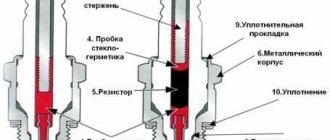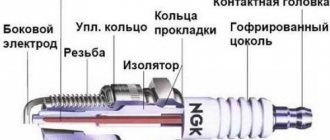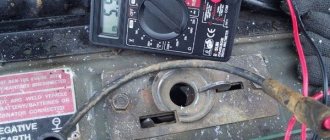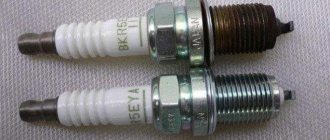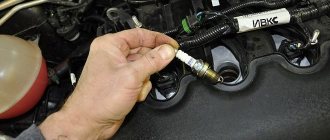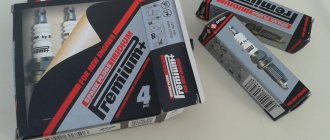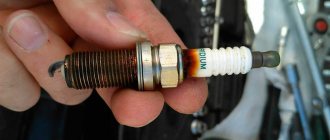Good afternoon, dear readers! I decided to devote today’s post to adjusting the spark plug gaps on a VAZ 2107 car. If you have problems starting the car engine, engine tripping, then I recommend that you read this article. Perhaps she can solve your problem.
The spark plug gap is the gap between the side and center electrodes of a car spark plug. Depending on the type of engine and power system, the spark plug gap may have one or another value. Typically, at a spark plug manufacturing plant, the gap is already set and does not need to be adjusted, although it can be corrected.
How does ignition work in a cylinder?
If we talk about spark plugs, then this is like the last link in the ignition system, which is in direct contact with the air-fuel mixture. It is this element that sets it on fire, and does it either effectively and as laid down in the technical regulations, or ineffectively for a number of reasons (by the way, wear is often to blame).
After the fuel mixture (gasoline and air) has been supplied to the cylinders, the piston begins to go up and compress it, thereby increasing pressure.
At the peak or, as is commonly called, the “top point,” the ECU gives an order and this composition ignites. Moreover, it is ignited by the spark plug - a spark runs between the electrodes, which is the catalyst.
However, ignition may not occur, I am not currently considering options with a faulty ignition system, it’s just that the gap is set incorrectly. Thus, “missing” may occur (that is, the fuel mixture does not ignite), which will cause your engine to operate with low efficiency, and sometimes it will not start at all (for example, in the morning in winter). But why does this happen?
The influence of the correct clearance on engine performance
The gap is a really important parameter. It can either be big or too small.
Small gap
If small values are set between the electrodes, then misfires will occur in the ignition system. The thing is that the spark that forms between the electrodes, which are as close to each other as possible, is not enough to ignite the fuel mixture. The spark, although strong, is not sufficient. This is why many cars will really jerk when driving and not develop enough speed. The carburetors may have flooded spark plugs, which will only cause problems – it will generally cause problems. The gap needs to be increased!
How much is a small gap? If we talk about size, it is approximately from 0.1 to 0.4 mm. We definitely check the candles after purchase, I’ll give practical recommendations below, but for now let’s talk about long distances.
Big gap
You know, many manufacturers set the normal distance between the electrodes in advance. But over time, it can increase on its own.
It's all about spark plug wear, which manifests itself with high mileage - this is natural. After all, the electrodes are made of metal, which, under the influence of temperature and constant electrical discharges, begins to slowly burn out. Both the upper one, which resembles the letter “G”, and the lower one suffer. The top one becomes thin, instead of a rectangular shape, it begins to be rounded, because the sides burn out. The bottom one just sags down.
Due to this distance, the spark that passes between the contacts weakens. And significantly! It may also not be enough to ignite the fuel.
Often, because of this, the insulator of the lower contact is pierced; the whole point is that the spark tries to find the shortest path between the electrodes.
In winter, there is a high probability that the car simply will not start.
Another important aspect is that deposits in the form of soot may more often appear on distant electrodes; the spark “suffers” from the long distance, and so does deposits! It may not pass at all. Therefore, it is important after a certain mileage, with our fuel it can be already 15,000 km, to unscrew the spark plugs if necessary, change them, or clean them.
Large distance - from 1.3 mm and above.
Spark plugs for VAZ 2110, 2111, 2112 – which ones to put on the injector and carburetor
The spark plugs on the VAZ 2110/2111/2112 have a nickel central electrode, single-pin. For the VAZ 2110 the base engine is an 8-valve carburetor, for the 2111 it is also an 8-valve engine, but with an injector, and for the VAZ 2112 it is a 16-valve, injection engine. But in fact, each car was equipped with all these engines and their modifications. Therefore, spark plugs differ in the context of the 3 main base engines.
On each engine, the spark plugs have different markings, but for an 8-valve engine with an injector and carburetor they are the same and differ only in the size of the gap. Therefore, they can be interchanged by first setting the required gap. For VAZ carburetor engines, it is recommended to set it somewhere within 0.7 mm, but on injectors - 1 mm.
16-valve power units already have spark plugs that are slightly different from the previous ones. Therefore, it is not recommended to install them on 8-valve engines.
The dimensions and article numbers of the original candles are presented in the table below.
| vendor code | Engine | Thread / thread length, mm | Key size | Gap, mm | Heat number* | Center electrode material |
| 21080-3707010-86 | 8 valves, carburetor | M14x1.25 / 19 | 20.8 | 0.7 | 17 | Nickel |
| 21110-3707010-86 | 8 valves, injector | M14x1.25 / 19 | 20.8 | 1 | 17 | Nickel |
| 2112-3707010-01 | 16 valves, injector | M14x1.25 / 19 | 16 | 1 | 17 | Nickel |
*according to Champion nomenclature
In fact, under the article numbers 21080-3707010-86 and 21110-3707010-86, which go to 8-valve valves, there is the same model of spark plug, only with a different gap. Directly from the manufacturer, it has the article number A17DVRM, the average price is 140 rubles/piece. And under the article number 2112-3707010-01 (for 16 valves) there is a spark plug AU17DVRM, the average price is 200 rubles/piece.
The most commonly used substitutes are listed below. Ten and eleven have the same analogues, only before installation it is recommended to check the gap and, if necessary, set it to the recommended values.
| Manufacturer | vendor code | Price, rub (for 1 piece) |
| For 8 valve engines, injector and carburetor | ||
| Bosch | 0242235663 | 100 |
| NGK | BPR6ES | 140 |
| Denso | W20EPR-U | 100 |
| For 16-valve injectors | ||
| BRISK | DR15YC | 70 |
| NGK | BCPR6E-11 | 150 |
| Denso | Q20PR-U11 | 115 |
It is worth saying that NGK spark plugs are a favorite among owners of these cars. They have the highest popularity and the most positive reviews.
From the factory, the VAZs in question are equipped with ordinary nickel spark plugs, which do not have the longest service life and have a low ignition rate of the fuel-air mixture. Therefore, drivers often resort to installing more expensive spark plugs with iridium thin electrodes. The cars in question are most often equipped with such spare parts from Denso. For VAZs with 8-valve engines, this is the IW20 model at a price of 590 rubles/piece. And for a car with a 16-valve engine - IK20 with a price of 520 rubles/piece.
Studies show that such candles have a “hotter” white spark. And due to the fact that the iridium electrode is several times thinner, the spark does not dissipate. In practice, there is a slight improvement in the dynamic characteristics of the motor, as well as a 3-4 times increased service life.
When to change spark plugs on a VAZ 2110/2111/2112?
According to the maintenance regulations for VAZ 2110, 2111 and 2112, spark plugs must be changed every 30 thousand km. According to the experience of the owners, their actual service life is slightly lower, and rarely reaches 25 thousand km. This is especially true if the car is operated in difficult conditions, or in severe frosts, since when starting a very cool engine, they can be filled with gasoline.
Well, aunts and uncles, are you ready for this outrage? - Yes?! - then your friend’s car needs to be technically sound. That for this you need to write a lot and tediously, but today I will write (while thoughts in my head are wandering from idleness) about spark plugs, especially this week (now Moscow time 19-13, 09/24/2013) in the capital of our Motherland, Moscow Wet snow and frost were predicted. Why am I saying this - to the fact that if the spark plugs are not working properly, then the ignition system is faulty, and therefore it is difficult or impossible to start the heart of our friend the car - the Engine (I will call it the ICE). Let's start with diagnosing the internal combustion engine based on the condition of the spark plugs. Don't be surprised, diagnostics are not only computer-based (although it would be more accurate to say using a computer, software and special diagnostic devices (scanner, oscilloscope...) connected to the computer and reading the necessary information from the car - the computer is only recognizes and converts output signals from these devices, if anyone in Moscow needs “computer” diagnostics, call 8-968-933-79-07
).
And so, when the engine has cooled down, we unscrew the spark plugs, preferably one at a time (there is an opinion that if we don’t change the spark plugs, then from where we unscrewed them back in), and look at the color of the spark plugs: 1. A thin layer of light gray or light brown plaque.
The engine is in technically sound condition.
The spark plug corresponds to the given engine in terms of thermal characteristics. Related symptoms:
Fuel consumption, engine oil and toxicity meet standard requirements.
Prevention:
Every 10 thousand km.
mileage of the car, check the spark plugs and, if necessary, remove carbon deposits and adjust the spark gap. 2. Matte black soot
Mixture too rich.
Incorrect carburetor (fuel injection) adjustment. Air filter dirty. Incorrect ignition timing or poor high-voltage cable connection. The spark gap is too small - poor ignition of the mixture. The spark gap is too large - misfire. The spark plug is cold for this engine. A crack in the insulator means misfire. Incorrect operating conditions - prolonged idling or driving at low speeds. Associated symptoms:
Increased fuel consumption, decreased engine power, unstable idling, difficult starting.
Corrective measures:
Adjust the carburetor and ignition.
Grind in the valves. Replace the air filter. Adjust or clean spark gap. Replace the spark plug. 3. Shiny black oily deposit Oil entering the combustion chamber. Wear of piston rings and cylinder. Associated symptoms:
Causes difficult starting, cylinder misfires and jerking of the running engine. Increased oil consumption, unstable idling.
Corrective measures:
The cylinder head and piston group of the engine need to be repaired, the spark plugs need to be replaced.
4. Ash deposits on the spark plug electrodes
Light brown deposits that crust over the center and side electrodes.
Isolated from additives to oil or gasoline. Associated symptoms:
a large amount of deposits leads to misfires and interruptions in vehicle acceleration.
It is difficult to start the internal combustion engine. Corrective measures:
change the fuel or gas station (a large number of additives are not good, for example, a year of operation of 95-grade gasoline with special additives (I will not mention the brand of gasoline), the fuel pump of a VAZ 2110 1.5i 8kl killed to death), wash the injectors and the engine ( or as people say, we wash the injector, by the way, if anyone needs to wash the engine or injectors, including with ultrasound, you are welcome to
call Moscow 8-968-933-79-07
, we also diagnose cars), wash the throttle assembly, replace or clean the mesh - fuel pump filter, change spark plugs and oil.
5. Melting or burnout of electrodes, cracks on the thermal cone of the insulator or its destruction
, a spark plug that is too “hot” for a given engine, problems with the cooling system, ignition timing too early.
May cause damage to the internal combustion engine. Associated symptoms:
Interruptions in engine operation, difficult to start.
Engine overheating, detonation. Corrective Action:
Replace the spark plug. Check the serviceability of the cooling and lubrication system devices. Adjust the ignition timing.
Normal gap, what you need to focus on
We have very specific limits. Bottom from 0.4 mm (and everything below), top from 1.3 mm (and everything above). So what is considered the normal size for your car?
You know, there are differences here too, they are connected primarily with the car’s ignition system, which can be roughly divided into three types:
1) For carburetor type, with distributor - normal clearance is from 0.5 to 0.6 mm
2) For carburetor type, with electronic ignition – 0.7 – 0.8 mm
3) Injector – 1 – 1.3 mm
Why such difference? - you ask. The answer is simple - it's a matter of the ignition system and electrical circuit. The carburetor has the lowest voltage, so the spark will be weaker, and therefore the gap should be smaller. But the injector has the strongest energy system, so here the gap is increased, normal is considered to be 1 mm, and on many foreign cars it is 1.1 mm.
Setting the advance angle
If repair work was carried out on the VAZ 2105 ignition distributor or the device was replaced, adjustment is required after installing it on the car. This can be done in different ways, which depend on the conditions and the tool at your disposal. Before you begin the adjustment process, you need to know that the engine cylinders operate in the following order: 1–3–4–2, counting from the crankshaft pulley.
Control
This method will require the following tools and accessories:
- 12 V test lamp with two wires;
- key for 13 and 38 to turn the crankshaft.
The adjustment is made with the engine off and consists of the following steps:
- Remove the cover from the ignition distributor.
- Rotate the crankshaft until the mark on the pulley coincides with the middle mark on the front of the engine.
Before adjusting the ignition, it is necessary to align the marks on the crankshaft pulley and the front engine cover
- Use a 13 key to loosen the fastening of the distributor.
Before adjusting the ignition, it is necessary to loosen the nut securing the distributor
- We connect one wire from the lamp to ground, the other to the low voltage circuit in the distributor.
- Turn on the ignition by turning the key in the lock and rotate the device left and right until the light bulb appears. When it lights up, fix the distributor with the appropriate fasteners.
The ignition is adjusted more accurately while driving, since the required ignition timing directly depends on the quality of the fuel.
Video: setting the ignition using a warning light
By hearsay
The simplest and most accessible option for setting the ignition is by ear. This method is especially indispensable in field conditions. The adjustment consists of the following steps:
- Let's start the engine.
- Lightly unscrew the distributor mount, holding the device from turning with your hand.
- We try to turn the distributor to one side.
When adjusting, the distributor is rotated to the right or left
- We find a position in which the engine operates at maximum speed.
- Turn the distributor slightly clockwise.
- We clamp the mechanism fastening.
Video: installing the Zhiguli ignition by ear
By spark
The sequence of actions when setting the spark advance angle consists of the following steps:
- We install the crankshaft according to the marks, as in step 2 when adjusting using a light bulb, while the distributor slider should be directed towards the first cylinder. If he is looking at the fourth cylinder, then he needs to crank the crankshaft some more.
Position of the distributor slider: 1 — distributor screw; 2 — position of the slider for the first cylinder; a - location of the contact of the first cylinder in the cover
- We remove the central cable from the distributor cover and place the contact near ground.
- We loosen the distributor fastening, turn on the ignition and turn the mechanism until a spark jumps between the explosive wire and the ground.
- We move the distributor little by little counterclockwise and find a position in which a spark will not appear, after which we secure the distributor.
By strobe
You can most accurately set the ignition timing on the “five” using a strobe light. The adjustment technique consists of the following steps:
- Lightly unscrew the distributor fasteners.
- We connect the negative contact of the device to ground, connect the plus one to the low-voltage part of the ignition coil, and attach the strobe clamp to the cable of the first cylinder.
- We start the engine and turn on the device, pointing it at the crankshaft pulley. With such actions, the mark will be visible.
- We turn the distributor and ensure that the mark from the strobe light matches the marks on the engine.
- We control the engine speed, which should be 800–900 rpm.
- We fix the adjustable mechanism.
Video: setting the lead angle using a strobe light
The serviceability of each element of the ignition system has a direct impact on the functioning of the engine. Therefore, attention should be paid to checking them periodically. If malfunctions occur in the operation of the motor, you need to be able to find the cause of the malfunction and eliminate it. To do this, it is enough to prepare a minimum list of tools, familiarize yourself with the step-by-step actions and carry them out as you work.
Modern technologies
What I want to say in conclusion, many will think “come on,” why should I bother with some distance between the electrodes! Guys, very wrong thoughts.
Firstly , you can save on fuel, studies show up to 5 - 7%
Secondly , smooth engine operation is the key to driving safety.
Third , the correct gap between the spark plugs increases their service life; there is no chance that the insulator will break through (with an increased distance).
I would like to note that some companies, on the contrary, increase the number of contacts (electrodes), strengthen the coils and the ignition system, all so that the mixture is ignited better.
There are also more modern technologies now, which I think will soon replace them - such as plasma candles.
They have no electrodes at all, and the fuel is ignited by a beam of plasma that is generated by electricity. As they write, the production is now undergoing tests and they say that the combustion efficiency of the fuel mixture is increasing, which means a little more power, a little more economy and environmental friendliness of the engine.
And that’s all for me, read our AUTOBLOG, it will be interesting.
( 27 votes, average: 3.81 out of 5)
At the moment, there are several types of internal combustion engines - gasoline and diesel. And if for the latter to work, ignition of the mixture is not required (it burns from the force of compression), then in the case of gasoline engines a spark is required. It is produced by a special element - a candle. These are available on injection and carburetor cars. During operation, motorists often wonder what gap should be on the spark plugs. Today we will talk about this topic in more detail.
The spark plug is the last element that comes into contact with the fuel-air mixture. Its main function is to ignite the fuel at the moment when the piston is at top dead center. The voltage is supplied from high-voltage wires. In turn, the interval between spark supply is set by the ignition coil. When the piston is at TDC, a spark runs between the spark plug electrodes. It is the catalyst for this process.
The mixture ignites and the compression energy is transferred to the piston. After the gases are removed, the process is repeated again. However, in order for a spark to be able to properly pierce the electrodes and ignite the mixture, the gap must be optimal. It changes during use. Thus, a distinction is made between small and large gaps. We will discuss further how they affect engine operation.
If the gap between the electrodes is small (less than 0.4 millimeters), this will first of all manifest itself in the way the engine operates. In this case, the owner will observe misfires. Why is this happening? The fact is that a powerful spark is required to ignite the combustible mixture. And since the distance between the electrodes is small, its strength will be insignificant. As a result, the combustible mixture will ignite every other time. The engine starts to stall. On carburetor units the spark plugs often flood. This is not very good, since the motor is operating in overload mode.
Therefore, if the spark is weak and the gap is small, it needs to be increased as much as possible. But it is not so. If the gap is 1.3 millimeters or more, the spark simply will not pass between the electrodes. The engine will start to stall again. In addition to this, carbon deposits will appear on the candles. A breakdown of the lower contact insulator is also observed. This occurs because the spark tries to travel through the shortest path between the electrodes. In winter, such an engine may not start at all.
Note that the manufacturers themselves do not oblige you to check and adjust the gap (on iridium spark plugs as well). However, practice shows that over time this parameter automatically changes in one direction or another, since the spark plug is constantly under tension and high pressure. What to do in this case? Experienced motorists recommend checking the gap on the spark plugs every 15 thousand kilometers and, if necessary, adjusting the readings.
So we have some data. A small gap is anything below 0.4 millimeters. Large – 1.3 and above. What gap should the spark plugs be? It all depends on the type of food. On carburetor cars with a distributor ignition system, this parameter is 0.5-0.6 millimeters. But not all units should have such a gap on the spark plugs. A carburetor with electronic ignition works normally with a gap of 0.7-0.8 millimeters. What about modern cars with fuel injection? What gap should their spark plugs have? Experts recommend choosing a parameter of 1-1.25 millimeters. It is with this value that the engine operation will be as stable as possible, without skipping or tripping.
This is a separate topic for consideration. The gas mixture is slightly different from gasoline. The spark plug requires less force to create a spark. Accordingly, the gap should be about 0.7 millimeters. However, motorists say that even at 1.1 mm, a car with gas-cylinder equipment operates stably. Therefore, on gas units, adjusting the spark plug gap is no different from gasoline units. There are also so-called gas candles. The thickness of their electrode is slightly smaller than usual. However, reviews from car owners say that this did not give much effect. The car drives equally well on gas with both conventional and gas spark plugs. This is nothing more than a marketing ploy.
Tips for choosing the right spark plugs
If fuel consumption has increased, first check the spark plugs.
Properly selected spark plugs in good technical condition ensure a stable spark and efficient ignition of the fuel-air mixture. But what happens if one or more spark plugs fail? First of all, this will affect the engine starting. Its startup will be more difficult, with noticeable interruptions, and operation will no longer be smooth. Owners may also notice the appearance of floating speed when idling the engine. While driving, the car's dynamics may be significantly reduced when starting from a stop and accelerating. If these symptoms occur, pay attention to the spark plugs. The cause of the malfunction may lie in several factors at once: the spark plugs were incorrectly selected and their gap was set, or the service life recommended by the manufacturer was exceeded.
Incomplete ignition of the fuel-air mixture
If the electrode is worn out or excessive carbon deposits appear that prevent stable ignition, the spark plug does not ignite the entire mixture, but only a certain amount of it. If the spark plug does not produce a sufficient spark, you may notice an increase in fuel consumption and a decrease in acceleration dynamics, since the residual fuel-air mixture does not burn completely.
If the spark plug completely fails, then ignition does not occur in one of the cylinders. The main sign of a breakdown is the “triple” of the engine, that is, malfunctions in its operation. At idle, shaking and twitching of the engine can be felt, and if the vibration is particularly strong, it can be transmitted to the steering wheel, pedals, gearshift lever and other elements. Dips may occur when you press the gas, acceleration is accompanied by jerks, and the tachometer readings begin to “float.” In this case, an increase in fuel consumption is also observed.
Why is fuel consumption increasing?
Unstable operation of the spark plugs immediately affects the ignition of the mixture in the cylinders, and not completely burned fuel simply flies out into the exhaust system, thereby disabling the catalytic converter. In this case, the first thing we will see is increased fuel consumption. The exhaust system oxygen sensor reads and transmits information to a computer, which analyzes the data and compares it with information from the mass air flow sensor. Since the transmitted information is incorrect, an overly rich or, on the contrary, too lean mixture is created. As a result, the car loses power, and the driver is forced to press the gas pedal harder. This leads to a significant increase in consumption figures.
To avoid increased fuel consumption, it is recommended to follow just a few simple tips:
1. Pay attention to the service life of your car's spark plugs. If the mileage has already exceeded the time recommended by the manufacturer, be sure to buy a new set of spark plugs and replace them. For clarity, we give approximate indicators of increased fuel consumption: for nickel spark plugs, with a run of 10,000 km, consumption increases by approximately 1%, after 20,000 km - by 2%, and then in arithmetic progression.
2. Be responsible about the recommended spark plug replacement interval for your vehicle. First of all, you should focus on the manufacturer’s recommendations, which can be found in the Vehicle Service Book. They are developed individually for each model and take into account many specific factors, such as design features of the engine, climatic features of the region for which the car was produced, adjustments for fuel quality, etc.
Good afternoon, dear friends, although for some it may well be evening! I hasten to continue the series of publications, which is devoted to the fuel consumption of a modern internal combustion engine. Surely, each of you has heard at least once about how fuel consumption is affected. I have no doubt that this topic will be of interest to a wide range of car enthusiasts. Therefore, let’s dwell on it in more detail.
Driving style and circumstances
This guide covers potential problems that may be associated with using more fuel. One of the most common reasons for poor fuel economy is how you drive and the type of trips you take. Cars use the most fuel during initial acceleration, so if your car trip is short or includes many stops, you will inevitably use more fuel, which will last on longer trips where your speed and acceleration will be constant.
Let's start with the fact that many drivers are faced with a dilemma: whether to change the spark plugs only after actual wear, or to do it after a certain mileage, as recommended by manufacturers, even if the spark plugs are normal in appearance. An unscheduled replacement, of course, is a more correct solution, but let’s consider the situation of what happens if the replacement does not take place on time.
Additionally, aggressive driving, where you accelerate and brake, forces you to pump the engine with extra fuel and use more of it. To get the best mpg, keep your vehicle running as much as possible. Combine short trips and try to keep the acceleration at a constant speed. For a more in-depth look at eco-driving, please take a look at the Automobile Reference Guide.
As they get older, they may become less responsive. Faulty oxygen sensors can reduce gas mileage by 20% because the sensors tell the car it needs more fuel when it doesn't. The engine thermostat controls engine operating temperature, helping the engine warm up quickly after a cold start. A faulty thermostat does not close properly, allowing coolant to continue circulating while the engine warms up.
Many different criteria influence how long new (white) spark plugs can last. In many ways, this is influenced by the driving style of the car, their quality and manufacturer, the general condition in which the car’s engine is located, the quality and grade of fuel, etc. If the products are new, they can keep the engine running in optimal and efficient condition. At the same time, they themselves serve to create a spark with a discharge of tens of thousands of volts, which could ignite the air-fuel mixture in the cylinders in the shortest possible time.
This may mean that the car never reaches the desired operating temperature. Fuel injectors are responsible for delivering fuel to the engine. Fuel varnish deposits can build up inside the fuel injectors, preventing them from mixing fuel properly. This means less fuel makes it run and the mixture is lean, leading to backfire and poor fuel economy.
An engine misfire can be the result of many problems, faulty fuel injectors, faulty spark plugs, bad plug wires, fuel injectors, low fuel pressure, to name a few. A misfired engine will waste a large amount of fuel.
Design
If we take into account the design of the candles, then they consist of the following elements:
- Contact output. Serves to connect high-voltage wires from the ignition system;
- Insulator. Due to it, the candles do not overheat;
- Insulator ribs. Do not allow electrical breakdowns;
- Central and side electrode. Serves to form a spark between them, which ignites the fuel mixture;
- Seal. This element prevents hot gas from escaping from the combustion chamber.
An important point in the correct operation of spark plugs is the gap between the electrodes.
Step by step order
First of all, remove the plastic engine casing located on top. If the bolts are not covered with corrosion, they will easily unscrew.
Then disconnect the terminals from the individual ignition coils one by one. Using a “10” key, unscrew the bolt that secures it to the cylinder head cover. When the bolts are unscrewed, move it to the side.
Using a screwdriver, remove it from its seat and move it to the side. Inspect the spark plug wells for damage, and be sure to check for oil in them.
Gap
When performing a preventive check of spark plugs or while searching for the causes of an unstable engine, it is recommended to check the gap between the electrodes.
- If the gap is larger than normal, the spark will form more than usual, the mixture will begin to ignite more strongly, and the flow rate will be more stable. In this case, failures in the operation of the motor may occur.
- If the gap is smaller than required, the spark will begin to appear earlier than required. The small spark energy is not capable of effectively igniting the fuel mixture. This increases fuel consumption, but reduces engine power and worsens dynamics.
The gap between the electrodes on the injection VAZ 2110, according to the manufacturer’s recommendations, ranges from 1 to 1.13 millimeters.
Gap measurement
Setting the gap
The first step is to check whether the gap really deviates from the norm, and then take appropriate action. So, let's begin.
- Get to the spark plugs, having first disconnected the high-voltage wires from them.
- Use a feeler gauge to measure the distance between the two electrodes of your spark plugs. Special probes are sold that look like a folding knife.
- Take a feeler gauge whose blade is exactly 1 mm thick.
- Insert the probe into the gap between the electrodes.
- Normally the blade should go in with a slight pinch, but you don't have to use much force to get it in.
- If the blade is too loose, then the gap is too high. You will need to lightly press the upper electrode against the lower one until the required distance is formed.
- If the blade is difficult to fit into the gap, then it was smaller than required. In this situation, you will have to do the opposite, bend the electrode slightly.
Adjusting the distance
When increasing or decreasing the gap, do not apply too much force, otherwise you risk breaking the element. In this situation, there is nothing left to do but change the spark plug.
Adjusting the ignition of the VAZ 2107
Acceleration dynamics, fuel consumption, trouble-free engine starting and exhaust toxicity of carburetor VAZ 2107 directly depend on correctly installed ignition. If the ignition system (IZ) of newer injection models does not require special adjustments, then cars with an older contact system require periodic adjustment.
In what cases is ignition adjustment required?
Over time, the factory ignition settings get lost or no longer correspond to the operating conditions of the vehicle. Thus, the need to adjust the SZ arises when using low-quality fuel or fuel with a different octane number. To assess the feasibility of this procedure, the ignition timing is determined. This is done as follows.
- We accelerate the car to 40 km/h.
- We sharply press the accelerator pedal and listen to the sound of the engine.
- If noise appears and disappears when the speed increases to 60 km/h, then there is no need to adjust the SZ.
- If the noise and detonation do not disappear as the speed increases, then the ignition is early and requires adjustment.
If the ignition timing is set incorrectly, fuel consumption will increase and engine power will decrease. In addition, a number of other problems will arise - an incorrectly installed ignition will reduce the service life of the power unit.
If a spark forms on the spark plug earlier than expected, the expanding gases will begin to counteract the piston rising to the top position. In this case, they talk about early ignition. Due to too early ignition, the rising piston will expend more effort to compress the resulting gases. This will lead to an increase in load not only on the crank mechanism, but also on the cylinder-piston group. If a spark appears after the piston passes the top dead center, then the energy generated from the combustion of the mixture enters the exhaust without performing any useful work. In this situation they say that the ignition is late.
Required Tools
To adjust the ignition of the VAZ 2107 you will need:
- key to 13;
- screwdriver;
- spark plug key;
- special key for crankshaft;
- vol (12V lamp).
Symptoms of a problem
If the spark plugs fail, there will be no spark. Consequently, the fuel mixture will not be able to ignite, the engine will freeze and show no signs of life.
There are several telltale signs that may indicate poor spark plug performance.
- The engine starting procedure gets worse. The starter turns, but the motor itself does not respond;
- Fuel consumption increases;
- CO emissions increase;
- At idle and while driving, the engine begins to jerk the car;
- The dynamic performance of the car drops, it is not possible to raise the speed to the required maximum, the engine power noticeably decreases, etc.
But all these are indirect reasons, since they do not directly indicate the failure of the spark plugs. You can verify their malfunction only by checking.
Spark plugs VAZ 2110/2111/2112
VAZ 2110/2111/2112 cars are the tenth series of domestic cars produced since 1995. Such cars were produced only with gasoline engines (injector and carburetor).
Spark plugs for each car of the tenth family come with different part numbers, but in fact they are very similar in size and parameters. The differences in spark plugs on these three cars are due to different engines, although all of them are developed on the basis of a 1.5-liter 8-valve carburetor engine from a dozen.
The VAZ subsidiary Lada Image supplies original spark plugs to the assembly line. The original spare part is sold in Lada branded packaging. But the manufacturer is the domestic company OJSC ZAZS, Engels.
Cleaning
If the spark plugs are dirty, then it is not at all necessary to immediately replace them with new elements of the ignition system, igniting the fuel mixture in the combustion chamber of the VAZ 2110. Regular cleaning will quickly remove the dirt and return the spark plugs to their previous functionality.
There are several common cleaning methods that can be used at service stations and in garages with your own hands.
Regardless of the chosen method, we recommend that you follow the general principles of operation when cleaning the elements of the ignition system.
- Protect the coating of the spark plugs from abrasion; do not use rough sandpaper or other similar abrasives.
- Do not expose the candle to high temperatures. It is not worth heating them over a fire for the purpose of cleaning. Some people do this for some reason.
- Check the spark plug for resistance using a megometer. If the second scale does not show + infinity, then the spark plug will have to be changed. Cleaning is useless. With a value of 1000 it is also better not to try to resuscitate the element.
Now let's talk directly about cleaning methods.
Cleaning before and after
The formation of carbon deposits and flooding will require not only removing and drying the spark plugs, but also thoroughly cleaning them.
- One popular method is to remove carbon deposits with a fine-bristled wire brush;
- Another option is treatment with kerosene, which removes carbon deposits quite effectively;
- Another method involves the use of sandblasting. The effectiveness of this approach is short-term, so you will soon have to remove the candles again and clean them;
- Many people have also gotten used to using chemical converters. To do this, candles are placed in a solution, allowed to sit for about an hour, after which they are cleaned with matches, toothpicks to remove carbon deposits, washed with water and dried;
- In order not to buy specialized products, you can use acetone using the same cleaning principle;
- Our grandfathers cleaned candles with vinegar. To do this, you will need to dip them in vinegar for an hour, then add literally 5 drops of electrolyte;
- There is an ultrasonic cleaning method, but this requires specialized equipment.
If you do not get the desired result, you will have to change the candles. But first they need to be selected.
Choice
The choice of candles today is quite extensive. But we’ll talk about which ones are used for the VAZ 2110 and what can currently be considered the best choice for your car.
Candles differ from each other mainly in the material from which the electrodes are made.
Candle type
Peculiarities
These are classic spark plugs for VAZ, installed by the factory. The operating life is up to 50 thousand kilometers. Some of them are coated with yttrium alloy to increase the reliability of the electrode.
They are characterized by increased resistance to temperature fluctuations and corrosion, which has a positive effect on the service life of the elements. Such elements are capable of operating up to 90 thousand kilometers
The characteristics are in many ways close to platinum candles; today they are considered the most durable and high-quality. Safety margin - about 90-100 thousand kilometers
The service life may increase or decrease depending on the care, conditions of use of the vehicle, and the quality of the fuel being poured.
Platinum candle

